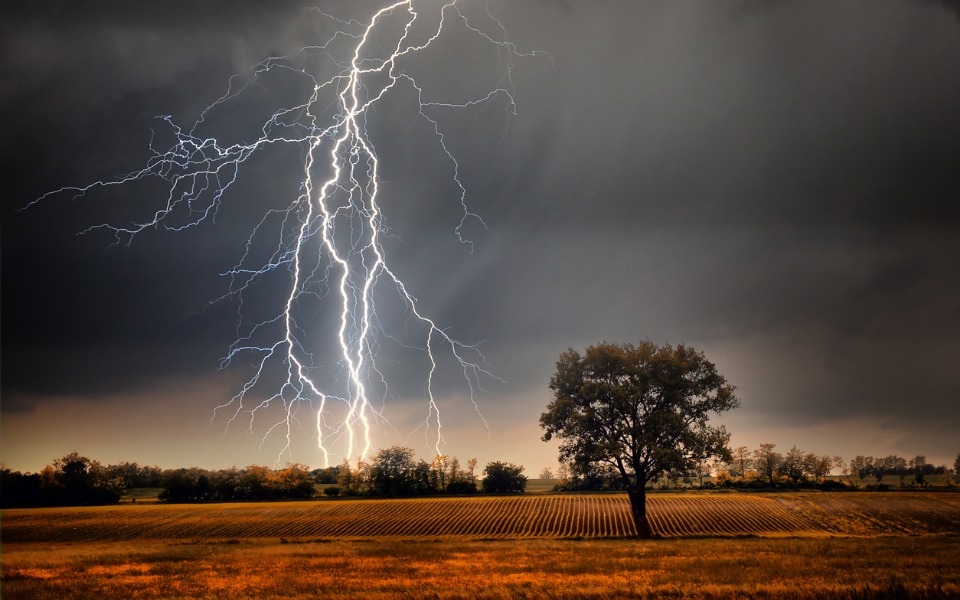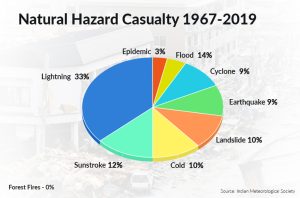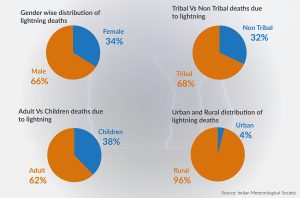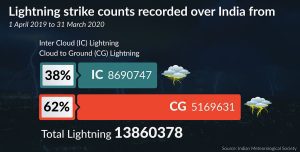
Lightning more fatal than cyclones, floods; killed 1,700 Indians last year
According to government data, between 1967 and 2019, lightning accounted for 33 per cent of deaths among natural calamities, followed by floods (14%), sunstroke (12%) and cyclones (9%)

Last week, lightning killed 24 of the 34 people who died in rain-related incidents in Maharashtra. The death toll due to lightning incidents touched 140 in Bihar this year, which remains one of the most-vulnerable states in the country. In Madhya Pradesh, around 110 people have died over a span of 40 days (till July 11).
Although lightning strikes and resultant deaths are often reported as isolated incidents, the above death toll proves that they are equally hazardous as cyclones and floods, especially for people in rural India.
Rising death toll
According to the Annual Lightning Report 2020-21, jointly published by the Ministry of Earth Sciences and the Indian Meteorological Department (IMD), around 1,697 people died in lightning strokes between 2020 and 2021, with the majority of incidents being reported from north Indian states.

The states of Madhya Pradesh, Uttar Pradesh and Bihar alone account for 60 per cent of the deaths caused due to lightning, government data says. Sanjay Srivastava, who works at the Climate Resilient Observing Systems Promotion Council (CROPC) told a news website that around 1,500 people died in the three states in the same time frame.
According to the government report, while Bihar reported 401 deaths, Uttar Pradesh reported 238, Madhya Pradesh 228 and Odisha 156.
Also read: What’s behind killer lightning strikes which haunt Marathawada
According to the report, lightning strikes rose by 34 per cent – from 1.38 crore in 2019-20 to 1.85 crore in 2020-21 – within a year.
Between 2016 and 2018, the National Disaster Management Authority (NDMA) had also reported an alarming rise in lightning deaths –1,489 in 2016, 2,067 in 2017 and 3,000 in 2018.
Why rural India is more vulnerable?
Data shows that the most affected by lightning strikes are areas in rural India. A report said that more than 96 per cent of the deaths due to lightning incidents are reported from rural and tribal pockets of the country.

Experts say villages are geographically more-likely to be affected by lightning due to the availability of ample space. A bolt of lightning vertically hits the ground and radiates to the neighbourhood in a circular manner. While the availability of space in rural areas helps it spread its radius, the same is thwarted by concrete buildings in urban spaces.
In villages, people working in farms or near rivers and ponds, all which are good conductors of electricity due to the presence of water, are killed when a bolt of lightning hits and spreads.
According to a report as part of the Lightning Resilient India Campaign 2019-2021, the intensity and frequency of lightning have shown a sharp rise in coastal and hilly areas as well as river basins.
The report titled ‘Tribals and Marginalised Most Vulnerable to Lightning’ said that tribal areas and those inhabited by marginalized sections of society were the most affected.
“Since lightning strikes are more in open areas, jungles and water bodies, tribals staying with nature are more vulnerable to it. Their houses are katcha/thatched roof and hence are not safe from lightning strikes,” the report said.
According to CROPC, a majority die in lightning strikes while standing under tall trees or inside their huts.
Around one fourth of the victims were those worked in the open including farmers, cattle-grazers, fishermen, labourers and those collecting firewood.
How global warming causes thunderstorms, lightning
Experts attribute the rise in frequency of lightning strikes and deaths to climate change.

Lightning is caused by the combination of cold air and warm air. Warm air tends to travel up in the atmosphere where the air is colder. While warm air has water droplets, cold air has ice crystals. When the two meet, the collision of ice crystals and water droplets causes electrical charges in the clouds. The clouds have a plus (positive) end on their top and minus (negative) end on the bottom, just like a battery. When the minus end grows strong, it releases energy which travels through air to a place which has positive charge. This bolt of energy or lightning is called a ‘leader stroke’. It can either go to another cloud or hit the earth. Thunder is the sound a bolt of lightning produces while travelling.
While the melting of glaciers is increasing the moisture content in the air, global warming is heating up the earth’s atmosphere more than earlier, producing the two key ingredients needed to cause lightning.
Scientists say factors such as deforestation, sudden change in weather leading to cloudburst, thunderstorms and frequent cyclonic storms also play a vital role in increasing the frequency of lightning incidents.
Lightning more fatal than cyclones, floods
According to a study on ‘Citizen Science Approach to Save Life’ published by CROPC in 2021, lightning accounted for 33 per cent of deaths caused due to natural calamities in India between 1967 and 2019. Floods came next with 14 per cent, while 12 per cent people died due to sunstroke and 9 per cent due to cyclones.
The National Crime Records Bureau (NCRB) also names lightning as a major cause of death among accidental deaths caused by natural forces. According to NCRB data, 2,862 people died due to lightning strikes in 2020, compared to 37 deaths caused by cyclones, 530 by heat stroke and 959 by floods.
Even though the government in 2019 launched the Lightning Resilient India Campaign in 2019 – a collaborative effort by CROPC, IMD, Indian Meteorological Society, National Disaster Management Authority, state government, academia and NGOs – to reduce lightning deaths in the country, experts say the numbers are still under reported.
Besides, despite the massive death toll it produces every year, lightning is yet to be notified as a natural disaster by the Ministry of Home Affairs.
Also read: NASA’s new mission to know why lightning strikes & storm intensity are up
In 2019, Uttar Pradesh, Odisha, Bihar, Madhya Pradesh, and Jharkhand reported the highest number of deaths due to lightning.
While the fatality rate has dropped by over 60 per cent in vulnerable states like Odisha, Andhra Pradesh and Nagaland between 2021-22, the same has seen an alarming rise Bihar (by 168 per cent), Punjab (331 per cent) and Haryana (164 per cent) – all which have an agricultural economy.
Mitigation measures
With lightning common during the onset of Kalbaishakhi (Norwesters) and the monsoon season, CROPC suggests local administrations in vulnerable states to issue early warning for farmers, cattle grazers and people who are likely to be in open spaces.
CROPC uses satellite observations, alerts from radars, and other lightning-detection sensors to forecast lightning.
The IMD can now forecast lightning 24 hours in advance.
That apart, the government in collaboration with IITM Pune has launched an app called Damini which monitors lightning occurrences across the country and alerts about a future strike ahead through GPS notification.


